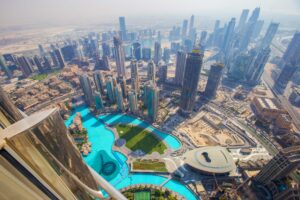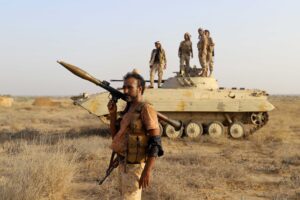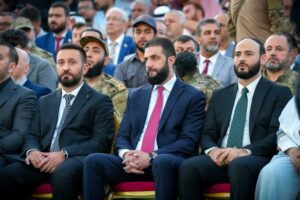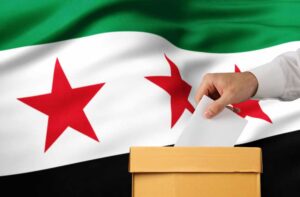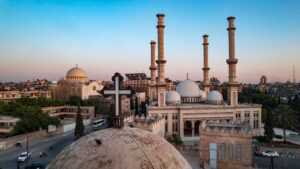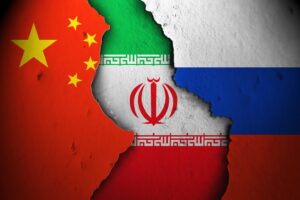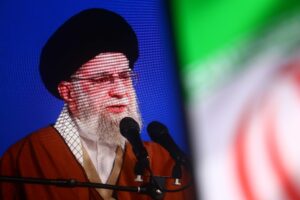Protests have jolted Iran following the September death of Mahsa (Jina) Amini, the young woman who died in the custody of Tehran’s morality police after her arrest for allegedly wearing hijab improperly. Iranian women have played a prominent role throughout the protests; their leadership of this movement and their slogan of “Woman, Life, Freedom” have captured international attention and earned the rhetorical solidarity of leaders from around the world.[i] Indeed, the women of Iran were named the “Heroes of the Year” for 2022 by Time magazine.[ii] Whilst the political context of Iran is different from that of its Arab neighbours, many of the factors shaping Iranian women’s political experiences have also been observed in the Arab world. The imposition of discriminatory laws, significant restrictions on political freedoms and the severe underrepresentation of women in formal political bodies are present throughout the region.
Women’s political mobilisation and participation are central to regional dynamics.
However, the elevation of women as revolutionary symbols is also a recurring pattern in the politics of the Middle East and North Africa.[iii] Women’s political mobilisation and participation are central to regional dynamics, yet it often takes major disruptive events like mass demonstrations to draw sustained global attention to these issues. Whilst this type of sudden recognition tends to veer towards hero worship and gender essentialism,[iv] the pioneering feminist scholar Cynthia Enloe explains that paying attention to women in politics—of all persuasions and at all levels—runs deeper than admiration. It is not, in other words, a matter of blindly putting women on a pedestal. Rather, as she cautions, “if one fails to pay attention to all sorts of women, one will miss who wields power and for what ends.”[v]
Women’s political participation cannot be understood in a vacuum. Options and avenues for political mobilisation are circumscribed by political context, and the current context of the MENA region is one of entrenched authoritarianism and widespread conflict-related fragility. However, as recent events in Iran demonstrate, it would be misguided to claim that women—both as individuals and as a political force—are passively subject to the whims of autocrats and the changing winds of conflict. Ultimately, women represent a variety of identities and adopt diverse political positions, some that align with the existing governing structures of their states,[vi] and others that envision radical change—even revolution.
A Tale of Two Ascensions
In September 2021, Najla Bouden was appointed Prime Minister of Tunisia, becoming the first woman head of government in the history of the Arab world. The announcement of Bouden’s appointment, taken on its own, would have seemed to be a major milestone for the MENA region, which has long been considered among the worst global performers in terms of women’s political participation. Yet, the news—assumed to represent an attempt to distract from President Kais Saied’s ongoing decimation of the democratic process—received a less-than-enthusiastic response from many quarters. Instead, it was greeted by sceptical headlines in the international press, such as “Tunisia has its first-ever female prime minister. That’s not as good for democracy as it sounds”[vii]; “Tunisia’s female PM: Mere symbolism or credible change?”[viii]; and “Activists call Tunisia’s first female prime minister mere distraction.”[ix]
An image that stands in stark contrast to Bouden’s ascension is a widely circulated photo of a young Sudanese activist, Alaa Salah, atop a car during mass protests in Khartoum in 2019.[x] In a moment of revolutionary solidarity and fervour, Salah, then a 22-year-old architectural engineering student, was moved to climb on top of the car and recite a poem to onlookers. Dressed in all white, Salah stood out among the crowd, prompting her photo to go viral, and for her to be dubbed Sudan’s Lady Liberty, Kandaka—a reference to Nubian queens—and, ultimately, a symbol of the revolution.[xi]
When taken together, these two climbs—the first in the birthplace of the Arab Spring and the second in a country that was swept up in the “second wave” of the movement in 2019—highlight that the bleak post-Arab Spring political situation has both narrowed and expanded the possible avenues of political mobilisation available to women. In some cases, regional governments have embraced women’s empowerment discourse[xii] for reasons of political expediency, while many—and often the same ones—have continued to crack down[xiii] on independent activism, particularly from women’s groups, and to undermine progress in areas prioritized by women activists.[xiv] At the same time, whilst women have been largely shut out of official Track One peace processes across the region, they have engaged in political action and advocacy at the grassroots level and been emboldened by increased contact with international actors who maintain an interest in promoting their participation. Overall, these paradoxes correspond to and shed light on broader trajectories of governance and stability across the region.
A Regional Survey: Women in Politics in the Absence of Democracy
Open political systems are not always conducive environments to women’s political participation.
Democracy and women’s empowerment are widely presumed to go together,[xv] and women’s rights activists and pro-democracy campaigners alike have called attention to an authoritarian backlash against women’s rights in recent years.[xvi] For this reason, global comparisons regarding women’s political participation are often drawn between democratic and non-democratic regimes. Yet, this type of analysis is not particularly instructive in relation to the MENA, as the region remains dominated by authoritarianism. Most regional states are classified as autocracies,[xvii] with Lebanon, Kuwait, Tunisia and Morocco among the only Arab states to be considered “partly free” in 2021.[xviii]
Importantly, authoritarian regimes of different stripes have historically exhibited a variety of attitudes on women’s rights and empowerment, and more open political systems are not always conducive environments to women’s political participation. For instance, Kuwait, which is often considered to have the most independent and powerful parliament in the Gulf, performs abysmally in terms of women’s political participation and ranks below all of its more authoritarian Gulf Cooperation Council (GCC) neighbours on women’s political empowerment.[xix] In fact, in Kuwait’s recent parliamentary elections, which took place in September 2022, the country elevated just two women to office after an all-male parliament was elected in 2020.[xx]
Across the region, women represented approximately 17 percent of parliamentarians as of 2021.[xxi] Whilst this number is staggeringly low, it is also important to situate it within a broader international context of women’s political exclusion, as the global average for women’s parliamentary representation remains around 26 percent.[xxii] Claiming a regionally unprecedented figure of 50 percent parliamentary representation for women, the United Arab Emirates (UAE) leads the Arab world in the political empowerment subindex of the 2022 Global Gender Gap Report, taking the thirtieth spot out of 146 countries—outperforming the United States and a number of other democracies.[xxiii] This is a direct result of the UAE’s 2019 adoption of a parity quota for women in its Federal National Council[xxiv]—a quasi-parliamentary body with little independence—and an example of precisely why scholars of women’s political participation draw a distinction between presence and influence, shifting the focus to “making women count, not just counting women.”[xxv]
More generally, however, a number of states across the region, including Iraq, Egypt and Morocco, have adopted quotas for women’s political representation, ranging from candidate quotas to reserved seats.[xxvi] Whilst not all quotas are created equally, often face pushback and must be considered within the contexts in which they are developed, the general academic consensus is that they are a useful tool to increase women’s political participation.[xxvii] In Tunisia, for instance, women won 47 percent of municipal council positions in 2018. This increase has been attributed to a post-Arab Spring electoral law that stipulated the equal representation of men and women at the top of candidate lists, as well as the alternation of men and women down the lists.[xxviii] The steep drop in the number of women candidates running in the December 2022 Tunisian parliamentary elections—which followed the government’s abandonment of gender parity measures—presents strong evidence of the impact of quotas.[xxix]
The post-Arab Spring era provides several examples of women capitalising on such windows of opportunity to exercise influence on political outcomes.
Indeed, in the Arab world, quota adoption—which is a relatively easy step to take in authoritarian contexts—is a more reliable predictor of women’s formal political participation than a state’s position on the democracy-autocracy spectrum. However, what remains uncertain is the substantive influence that women representatives operating within authoritarian political structures have exercised, along with their political and legislative priorities.[xxx]
In addition to the dynamics of authoritarianism, parts of the region remain embroiled in civil wars and severe economic and political crises. On the Fund for Peace’s (FFP) Fragile States Index—which measures the vulnerability of states to collapse—several Arab states, including Yemen, Sudan, Syria, Libya and Iraq, are considered to be among the most fragile in the world.[xxxi] In general, fragility does not lend itself to women’s empowerment—political or otherwise—as evidenced in the appearance of the FFP’s most fragile states at the bottom of gender equality indices. Yet, conflict and its resolution are theorized to open non-traditional societal roles to women,[xxxii] who are often forced to take on increased economic activities or even become heads of household in the absence of male relatives.[xxxiii] It is also argued that the immediate post-conflict period—a time characterized by institutions in flux and intense international attention—provides a window[xxxiv] to enhance women’s political inclusion, particularly through negotiated settlements and constitution-making processes.[xxxv]
The post-Arab Spring era provides several examples of women capitalising on such windows of opportunity to exercise influence on political outcomes. Although the process was nearly derailed by a political crisis, women were robustly represented in the drafting of the 2014 Tunisian constitution, a document which contained significant provisions on women’s rights and equality under the law.[xxxvi] Furthermore, Yemeni women secured a 30 percent quota during the 2013-2014 National Dialogue Conference (NDC), and ultimately managed to ensure the inclusion of some of their policy preferences, including a quota for all state bodies and an increase in the legal marriage age, in the NDC recommendations.[xxxvii] Of course, women’s advancements are not insulated from the broader political setbacks that have defined their countries’ trajectories. The 2014 Tunisian constitution was suspended by President Saied in 2021, and Yemen’s NDC outcomes were never implemented following the outbreak of the ongoing civil war in late 2014.
Critically, conflict also courts international intervention, thereby increasing contact among local women’s activists and international organisations with the resources to amplify their voices. Elevating women to play a role in peacebuilding and peacemaking is a priority for many of these actors, including the United Nations,[xxxviii] which has sponsored peace processes in Syria, Yemen and Libya and been involved in a variety of roles in other transitional contexts across the region. In conflict-affected states, peacemaking is, at least from the perspective of international actors, where women’s presence is needed most. Their support for women’s consultative and advisory bodies like the Women’s Pact for Peace and Security (Tawafuq) and the Technical Advisory Group (TAG) in Yemen[xxxix] and the Syrian Women’s Advisory Board (WAB)[xl] do well to demonstrate the role international organisations purport to play in putting women near the political centre of conflict-affected states.
However, many women activists believe that these efforts have not gone far enough,[xli] as groups like the TAG and the WAB remain marginalised from the official—yet stalled—negotiations. Additionally, the UN has been unwilling or unable to convince regional conflict parties of the imperative to include women in their delegations. Regarding the Yemen case specifically, just a handful of women participated in the 2016 and 2018 peace talks in Kuwait and Stockholm, and no women were involved in the negotiation of the 2019 Riyadh agreement between Yemeni parties.[xlii]
Women...face an uphill battle in avoiding cosmetic or merely symbolic representation in dictatorships.
Despite this exclusion at the official level, women have mobilised in unique ways in conflict-affected states. In Yemen, for example, women have been active in negotiating and facilitating prisoner exchanges between the Houthi movement and the internationally-recognised government.[xliii] Similar examples of local mediation and leadership have been observed in diverse contexts in Iraq, Libya and Syria.[xliv]
Beyond Admiration and Towards Analysis
Women, along with their supporters, face an uphill battle in avoiding cosmetic or merely symbolic representation in dictatorships, and are at pains to convince conflict parties to include them in negotiations concerning the future of their countries. Nevertheless, every day, women—whether elected, appointed, in protest, or in their local communities and homes—claim political space, even as recent survey results from the Arab Barometer shed light on the persistence of traditional attitudes on gender roles. In nine of the twelve countries surveyed, a majority of participants agreed with the statement that men are generally better at political leadership than women.[xlv]
The Arab world supplies a diverse set of examples of women in politics.
Tunisia, however, has seen the largest decline in the belief of men’s superior political capacities in the Arab world. Some have claimed that this attitudinal shift is due, at least in part, to Najla Bouden’s appointment, citing a role-model theory of women in politics in which the elevation of a woman leader normalises women’s participation in the political realm.[xlvi] Whilst this theory is likely valid, it does not follow that opportunities for women to demonstrate political acumen exist only at the official governmental level. Women from a variety of backgrounds and at a multitude of levels are challenging stereotypes, taking on new roles and exhibiting political leadership. It remains to be seen what their influence on public attitudes will be in the long term, or even if their contributions will be recognised as political.
In a statement at the 2019 UN Security Council Open Debate on Women, Peace and Security, Alaa Salah—Kandaka of the Sudanese Revolution—reflected on her unlikely journey to the centre of international politics:
I did not grow up around politics, but in an ordinary middle-class family. . . But, as I would walk to university every day and see my fellow citizens around me, struggling to get food and medicine, half of the country living in poverty, how could one not become political?[xlvii]
The Arab world supplies a diverse set of examples of women in politics. These range from the thousands who have been inspired by the politics of daily life to mobilise in conflict-affected states and in authoritarian contexts, to the politicians elevated to office—whether through quotas or otherwise—who often enter the political sphere at great personal risk.[xlviii] An evaluation that does not incorporate all of these women and their political points of view would fail in two ways: first, it would overlook the ways in which women’s participation and exclusion are fundamental to the preservation of the status quo; and second, it would ignore the many strategies women have used to effect change from the bottom up. To fully appreciate how power is wielded in the region today, political analyses should take a cue from the prominent Iranian protest slogan and place women, their lives and their limited freedoms at the centre.
[i] Zoe Marks, et al., “Iran’s Women on the Frontlines,” Foreign Affairs, 31 October 2022, https://www.foreignaffairs.com/iran/irans-women-frontlines.
[ii] Azadeh Moaveni, “2022 Heroes of the Year: Women of Iran,” Time, 7 December 2022, https://time.com/heroes-of-the-year-2022-women-of-iran/.
[iii]“Women and the Arab Spring: Taking Their Place?”, The International Federation for Human Rights (FIDH), 2012, https://www.fidh.org/IMG/pdf/femmesarabangbassdef.pdf.
[iv] Gender essentialism refers to the attribution of fixed and distinctive qualities to men and women. In conversations about politics, this thinking most often appears in claims about women’s inherent peacefulness and cooperative nature, which are claimed to emerge from the “socially constructed roles women play as caregivers, nurturers, and collaborators.” See: Catherine Powell, “How Women Could Save the World If Only We Would Let Them: From Gender Essentialism to Inclusive Security,” Yale Journal of Law and Feminism 28(2), 2017, https://genderandsecurity.org/projects-resources/research/how-women-could-save-world-if-only-we-would-let-them-gender-essentialism.
[v] Cynthia Enloe, “Gender Makes the World Go Round,” in Bananas, Beaches, and Bases, University of California Press, 2014, https://www.ucpress.edu/book/9780520279995/bananas-beaches-and-bases.
[vi] See, for instance: Anchal Vohra, “It’s Woman vs. Woman in Iran’s Protests,” Foreign Policy, 7 November 2022, https://foreignpolicy.com/2022/11/07/its-woman-vs-woman-in-irans-protests/.
[vii] Lihi Ben Shitrit, et al., “Tunisia Has Its First Ever Female Prime Minister. That’s Not as Good for Democracy as it Sounds,” Monkey Cage, The Washington Post, 13 October 2021, https://www.washingtonpost.com/politics/2021/10/13/tunisia-has-its-first-ever-female-prime-minister-thats-not-good-democracy-it-sounds/.
[viii] Jennifer Holleis et al., “Tunisia’s Female PM: Mere Symbolism or Credible, DW, 30 September 2021, https://www.dw.com/en/tunisias-first-female-pm-mere-symbolism-or-credible-change/a-59367133.
[ix] Elizia Volkmann, “Activists Call Tunisia’s First Female Prime Minister a Mere Distraction,” Al-Monitor, 18 October 2021, https://www.al-monitor.com/originals/2021/10/activists-call-tunisias-first-female-prime-minister-mere-distraction.
[x] Zeinab Mohammed Salih, “I Was Raised to Love Our Home: Sudan’s Singing Protester Speaks Out,” The Guardian, 10 April 2019, https://www.theguardian.com/global-development/2019/apr/10/alaa-salah-sudanese-woman-talks-about-protest-photo-that-went-viral.
[xi] Randa Ali, “Poetic Photo of Sudan’s ‘Lady Liberty’ Sheds Light on Anti-government Protests,” ABC News, 10 April 2019, https://abcnews.go.com/International/poetic-photo-sudans-lady-liberty-sheds-light-anti/story?id=62296088.
[xii] Kaitlyn Hashem, “Is Feminist Foreign Policy Heading to the Gulf?”, The National Interest, 17 December 2022, https://nationalinterest.org/feature/feminist-foreign-policy-heading-gulf-206019.
[xiii] “Saudi Arabia’s ‘Year of Shame’: Crackdown on Critics and Rights’ Activists Continues,” Amnesty International, 14 May 2019, https://www.amnesty.org/en/latest/press-release/2019/05/saudi-arabias-year-of-shame-crackdown-on-critics-and-rights-activists-continues/.
[xiv] Kenza Ben Azouz, “President Saied Derides the Economic and Social Rights of Tunisian Women,” Human Rights Watch, 1 September 2022, https://www.hrw.org/news/2022/09/01/president-saied-derides-economic-and-social-rights-tunisian-women.
[xv] See: Daniela Donno et al., “International Incentives for Women’s Rights in Dictatorships,” 2022, Comparative Political Studies, 55(3), 451–492, https://danieladonno.files.wordpress.com/2021/07/donno-fox-kaasik-cps.pdf.
[xvi] Erica Chenoweth and Zoe Marks, “Revenge of the Patriarchs,” Foreign Affairs, March/April 2022, https://www.foreignaffairs.com/articles/china/2022-02-08/women-rights-revenge-patriarchs.
[xvii] “Democracy Report 2022: Autocratization Changing Nature?”, V-Dem Institute, 2022, https://v-dem.net/media/publications/dr_2022.pdf.
[xviii] “Global Freedom Status,” Freedom House, https://freedomhouse.org/explore-the-map?type=fiw&year=2022.
[xix] “Global Gender Gap Report 2022,” World Economic Forum, 13 July 2022, https://www.weforum.org/reports/global-gender-gap-report-2022/.
[xx] “Women Return to Kuwait Parliament for First Time Since 2020,” The National, 30 September 2022, https://www.thenationalnews.com/gulf-news/2022/09/30/women-return-to-kuwait-parliament-for-first-time-since-2020/.
[xxi] “Proportion of Seats Held by Women in National Parliaments – Middle East and North Africa,” The World Bank, https://data.worldbank.org/indicator/SG.GEN.PARL.ZS?locations=ZQ.
[xxii] “Facts and Figures: Women’s Leadership and Political Participation,” UN Women, 19 September 2022, https://www.unwomen.org/en/what-we-do/leadership-and-political-participation/facts-and-figures#_National_parliaments.
[xxiii] “Global Gender Gap Report 2022,” World Economic Forum, 13 July 2022, https://www.weforum.org/reports/global-gender-gap-report-2022/.
[xxiv] “Gender Quotas Database: United Arab Emirates,” International Institute for Democracy and Electoral Assistance (IDEA), https://www.idea.int/data-tools/data/gender-quotas/country-view/43/35.
[xxv] Thania Paffenholz, et al., “Making Women Count – Not Just Counting Women: Assessing Women’s Inclusion and Influence on Peace Negotiations,” UN Women, October 2015, https://www.unwomen.org/sites/default/files/Headquarters/Attachments/Sections/Library/Publications/2017/Making_Women_Count-EN.pdf.
[xxvi] “Gender Quotas Database,” International Institute for Democracy and Electoral Assistance (IDEA), https://www.idea.int/data-tools/data/gender-quotas/country-overview.
[xxvii] Madison Schramm, “Do Quotas Actually Help Women in Politics?”, Georgetown Institute for Women, Peace and Security, 22 January 2019, https://giwps.georgetown.edu/do-quotas-actually-help-women-in-politics/.
[xxviii] “Historic Leap in Tunisia: Women Make Up 47 Percent of Local Government,” UN Women, 27 August 2018, https://www.unwomen.org/en/news/stories/2018/8/feature-tunisian-women-in-local-elections.
[xxix] Sharan Grewal, “Tunisia’s Parliamentary Election Draws a Collective Shrug,” The Brookings Institution, 21 December 2022, https://www.brookings.edu/blog/order-from-chaos/2022/12/21/tunisias-parliamentary-election-draws-a-collective-shrug/.
[xxx] Marwa Shalaby, “Women’s Political Representation and Authoritarianism in the Arab World,” Women and Gender in Middle East Politics, POMEPS 19, 10 May 2016, https://pomeps.org/women-and-gender-in-middle-east-politics.
[xxxi] “Fragile States Index 2022,” The Fund for Peace, 2022, https://fragilestatesindex.org/global-data/.
[xxxii] Melanie M. Hughes and Aili Mari Tripp, “Civil War and Trajectories of Change in Women’s Political Representation in Africa, Social Forces, Volume 93, Issue 4, June 2015, Pages 1513–1540, https://journals.sagepub.com/doi/10.1177/0022002720983409.
[xxxiii] See, for example: “Syria’s Conflict Brings About Sweeping Changes in the Lives of Women,” CARE, 13 March 2020, https://www.care.org/news-and-stories/press-releases/syrias-conflict-brings-about-sweeping-changes-in-the-lives-of-women/.
[xxxiv] “Advancing Women’s Participation in Post-Conflict Reconstruction,” Georgetown Institute for Women, Peace and Security, 2020, https://uaeun.org/app/uploads/2020/11/UAE-GIWPS-Research-Report.pdf.
[xxxv] Yet, some scholars have highlighted that these processes tend to benefit a privileged subset of women and have the potential to create new hierarchies. See: Marie Berry and Millie Lake, “On Inconvenient Findings,” The Duck of Minerva, 5 January 2021, https://www.duckofminerva.com/2021/01/on-inconvenient-findings.html.
[xxxvi] Nanako Tamaru and Marie O’Reilly, “Case Study: Women Influencing Constitution Reform in Tunisia” in “How Women Influence Constitution Making After Conflict and Unrest,” Inclusive Security, January 2018, https://www.inclusivesecurity.org/wp-content/uploads/2018/02/How-Women-Influence-Constitution-Making.pdf.
[xxxvii] “Women in Peace and Transition Processes – Yemen (2011-2015),” Inclusive Peace and Transition Initiative, April 2018, https://www.inclusivepeace.org/wp-content/uploads/2021/05/case-study-women-yemen-2011-2015-en.pdf.
[xxxviii] “Women, Peace and Security,” UN Department of Political and Peacebuilding Affairs, https://dppa.un.org/en/women-peace-and-security.
[xxxix] “The Case for More Inclusive – and More Effective – Peacemaking in Yemen,” International Crisis Group, 18 March 2021, https://www.crisisgroup.org/middle-east-north-africa/gulf-and-arabian-peninsula/yemen/221-case-more-inclusive-and-more-effective-peacemaking-yemen.
[xl] “A Group of Women Has Bridged Differences Towards Peace in Syria,” UN Women, 1 November 2022, https://arabstates.unwomen.org/en/stories/feature-story/2022/11/a-group-of-women-has-bridged-differences-towards-peace-in-syria.
[xli] Maryam Alkubati, “Women’s Voices in Yemen’s Peace Process: Priorities, Recommendations, and Mechanisms for Effective Inclusion,” 25 January 2023, Sana’a Center, https://sanaacenter.org/publications/main-publications/19400.
[xlii] “The Case for More Inclusive – and More Effective – Peacemaking in Yemen,” International Crisis Group, 18 March 2021, https://www.crisisgroup.org/middle-east-north-africa/gulf-and-arabian-peninsula/yemen/221-case-more-inclusive-and-more-effective-peacemaking-yemen.
[xliii] Lauren Mellows, “Abductees’ Mothers Association: On the Front Lines of Yemen’s Prisoner Swap,” International Civil Society Action Network, 13 November, 2020, https://icanpeacework.org/2020/11/abductees-mothers-association-on-the-front-lines-of-yemens-prisoner-swap/.
[xliv] Jacqueline Parry, “Women’s Participation in Local Mediation,” UN Women, 2022, https://arabstates.unwomen.org/en/digital-library/publications/2022/06/womens-participation-in-local-mediation-lessons-from-iraq-libya-syria-and-yemen.
[xlv] MaryClare Roche, “Gender Attitudes and Trends in MENA,” Arab Barometer, 2022, https://www.arabbarometer.org/wp-content/uploads/ABVII_Gender_Report-ENG.pdf.
[xlvi] “Women in Tunisia: Has a Female Prime Minister Changed Tunisia?”, BBC, 12 July 2022, https://www.bbc.com/news/world-africa-62053997.
[xlvii] “Statement by Ms. Alaa Salah at the UN Security Council Open Debate on Women, Peace and Security,” NGO Working Group on Women, Peace and Security, 29 October 2019, https://www.womenpeacesecurity.org/resource/statement-unsc-wps-open-debate-october-2019/.
[xlviii] “Violence Targeting Women in Politics: Trends in Targets, Types, and Perpetrators of Political Violence,” ACLED, 8 December 2021, https://reliefweb.int/report/world/violence-targeting-women-politics-trends-targets-types-and-perpetrators-political. See also: Charlotte Bruneau, “Braving Intimidation, Hundreds of Iraqi Women Run for Parliament,” Reuters, 16 September 2021, https://www.reuters.com/world/middle-east/braving-intimidation-hundreds-iraqi-women-run-parliament-2021-09-16/.



